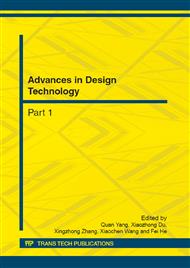[1]
CIGRE State of the art of conductor galloping (2007, p.140).
Google Scholar
[2]
R. Keutgen, J.-L. Lilien: A new damper to solve galloping on bundled lines. Theoretical background, laboratory and field results, IEEE Transactions on Power Delivery, Vol. 13, (1998), pp.260-265.
DOI: 10.1109/61.660887
Google Scholar
[3]
M. L. Lu, N. Popplewel, A. H. Shah, et al. Hybrid nutation damper for controlling galloping power lines, IEEE Transactions on Power Delivery. Vol, 22, (2007), pp.450-456.
DOI: 10.1109/tpwrd.2006.876653
Google Scholar
[4]
C. F. Earl, Some kinematics structures for robot manipulator designs, Journal of Mechanisms, Transmissions and Automation in Design. Vol.105, (1983), pp.15-22.
DOI: 10.1115/1.3267337
Google Scholar
[5]
Z. Huang, Q. C. Li, General methodology for type synthesis of symmetrical lower-mobility parallel manipulators and several novel manipulators, The International Journal of Robotics Research. Vol. 21, (2002), pp.131-146.
DOI: 10.1177/027836402760475342
Google Scholar
[6]
X. Kong, C. M. Gosselin, Type synthesis of 3-DOF spherical parallel manipulators based on screw theory, Journal of Mechanical Design. Vol. 126: (2004). P.101-108.
DOI: 10.1115/1.1637655
Google Scholar
[7]
X. Kong, C. M. Gosselin, Type synthesis of 3T1R 4-DOF parallel manipulators based on screw theory, IEEE Transactions on Robotics and Automation. Vol. 20: (2004), pp.181-190.
DOI: 10.1109/tra.2003.820853
Google Scholar
[8]
X. Kong, C. M. Gosselin, Type synthesis of 3-DOF PPR-equivalent parallel manipulators based on screw theory and the concept of virtual chain, Journal of Mechanical Design. Vol. 127: (2005), pp.1113-1121.
DOI: 10.1115/1.2044787
Google Scholar
[9]
J. M. Hervé, The Lie group of rigid body displacements, a fundamental tool for mechanism design, Mechanism and Machine Theory. Vol. 34: (1999), pp.719-730.
DOI: 10.1016/s0094-114x(98)00051-2
Google Scholar
[10]
C. C. Lee, J. M. Hervé, Uncoupled actuation of overconstrained 3T-1R hybrid parallel manipulators Robotica. Vol. 26, (2008), pp.103-117.
DOI: 10.1017/s0263574708004554
Google Scholar
[11]
Q. C. Li, Z. Huang, J. M. Hervé, Type synthesis of 3R2T 5-DOF parallel mechanisms using the Lie group of displacements, IEEE Transactions on Robotics and Automation. Vol. 20: (2004), pp.173-180.
DOI: 10.1109/tra.2004.824650
Google Scholar
[12]
J. Meng, G. Liu; Z. Li, A geometric theory for analysis and synthesis of sub-6 DoF parallel manipulators, IEEE Transactions on Robotics and Automation. Vol. 23: (2007), pp.625-649.
DOI: 10.1109/tro.2007.898995
Google Scholar
[13]
T. L. Yang, A. X. Liu; Q. Jin, et al. Position and orientation characteristic equation for topological design of robot mechanisms, Journal of Mechanical Design. Vol. 131: (2009), p.021001.
DOI: 10.1115/1.2965364
Google Scholar
[14]
G. Gogu, Structural synthesis of fully-isotropic parallel robots with Schöflies motions via theory of linear transformations and evolutionary morphology, European Journal of Mechanics/A Solids. Vol. 26, (2007), pp.242-269.
DOI: 10.1016/j.euromechsol.2006.06.001
Google Scholar
[15]
G. Gogu, Structural synthesis of maximally regular T3R2-type parallel robots via theory of linear transformations and evolutionary morphology, Robotica. Vol.27, (2009), pp.79-101.
DOI: 10.1017/s0263574708004542
Google Scholar
[16]
F. Gao, J. Yang, J. Q. Ge, Type synthesis of parallel mechanisms having the second class GF sets and two dimensional rotations, Journal of Mechanisms and Robotics.Vol. 3, (2011) p.011003.
DOI: 10.1115/1.4002697
Google Scholar
[17]
J. Yang, F. Gao, J. Q. Ge, et al. Type synthesis of parallel mechanisms having the first class GF sets and one-dimensional rotation, Robotica. Vol. 29, (2011), pp.895-902.
DOI: 10.1017/s0263574711000105
Google Scholar
[18]
Lung-Wen Tsai, Mechanism design: Enumeration of kinematic structures according to function, CRC Press LLC, (2001).
Google Scholar


